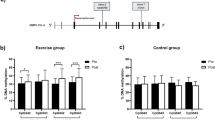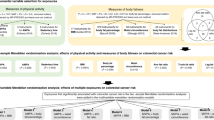Abstract
Background
Sitting time may affect health by altering the methylation of certain genes. This research aimed to estimate the association of sitting time with abdominal obesity and the role of Janus kinase 2 (JAK2) methylation in the association among rural adults.
Methods
A total of 1062 rural adults from the Henan Rural Cohort Study were included. Whole blood was used to extract genomic DNA. JAK2 DNA methylation level was assessed by MethylTargetTM. The logistic regression model was utilized to assess the association of sitting time with abdominal obesity, and the possible effect of JAK2 DNA methylation on the association were conducted by using mediation analyses.
Results
Average time of sitting of participants was 7.28 ± 3.37 h/d. For per 1 h increment in sitting time, the odd ratio (OR) and 95% confidence interval (CI) of abdominal obesity was 1.153 (1.095, 1.214) after controlling potential risk factors. Simultaneously, the methylation levels of Chr9: 4985407 site and Chr9: 4985238-4985455 region were negatively correlated with abdominal obesity (OR: 0.549, 95% CI: 0.394, 0.765; OR: 0.189, 95% CI: 0.056, 0.640, respectively). Moreover, Chr9: 4985407 site and Chr9: 4985238-4985455 region methylation levels mediated the association of sitting time with abdominal obesity, and the indirect effects account for 6.78% and 4.24%, respectively.
Conclusions
Longer sitting time was positively correlated with abdominal obesity in the rural population, and methylation level of JAK2 may be an underlying mediation of the effect.
This is a preview of subscription content, access via your institution
Access options
Subscribe to this journal
Receive 12 print issues and online access
$259.00 per year
only $21.58 per issue
Buy this article
- Purchase on Springer Link
- Instant access to full article PDF
Prices may be subject to local taxes which are calculated during checkout


Similar content being viewed by others
Data availability
The original contributions presented in the study are included in the paper/Supplementary Material; further inquiries can be directed to the corresponding authors.
References
Gornicka M, Hamulka J, Wadolowska L, Kowalkowska J, Kostyra E, Tomaszewska M, et al. Activity-Inactivity Patterns, Screen Time, and Physical Activity: The Association with Overweight, Central Obesity and Muscle Strength in Polish Teenagers. Report from the ABC of Healthy Eating Study. Int J Environ Res Public Health. 2020;17:7842.
Ross R, Neeland IJ, Yamashita S, Shai I, Seidell J, Magni P, et al. Waist circumference as a vital sign in clinical practice: a Consensus Statement from the IAS and ICCR Working Group on Visceral Obesity. Nat Rev Endocrinol. 2020;16:177–89.
Bhat ZF, Morton JD, Mason S, Bekhit AEA, Bhat HF. Obesity and neurological disorders: Dietary perspective of a global menace. Crit Rev Food Sci Nutr. 2019;59:1294–310.
Ma S, Xi B, Yang L, Sun J, Zhao M, Bovet P. Trends in the prevalence of overweight, obesity, and abdominal obesity among Chinese adults between 1993 and 2015. Int J Obes (2005). 2021;45:427–37.
Biddle SJH, Garcia Bengoechea E, Pedisic Z, Bennie J, Vergeer I, Wiesner G. Screen Time, Other Sedentary Behaviours, and Obesity Risk in Adults: A Review of Reviews. Curr Obes Rep. 2017;6:134–47.
Mahmoud AM. An Overview of Epigenetics in Obesity: The Role of Lifestyle and Therapeutic Interventions. Int J Mol Sci. 2022;23:1341.
Li X, Qi L. Gene-Environment Interactions on Body Fat Distribution. Int J Mol Sci. 2019;20:3690.
Moore LD, Le T, Fan G. DNA methylation and its basic function. Neuropsychopharmacology 2013;38:23–38.
Penas-Steinhardt A, Tellechea ML, Gomez-Rosso L, Brites F, Frechtel GD, Poskus E. Association of common variants in JAK2 gene with reduced risk of metabolic syndrome and related disorders. BMC Med Genet. 2011;12:166.
Shi SY, Luk CT, Brunt JJ, Sivasubramaniyam T, Lu SY, Schroer SA, et al. Adipocyte-specific deficiency of Janus kinase (JAK) 2 in mice impairs lipolysis and increases body weight, and leads to insulin resistance with ageing. Diabetologia 2014;57:1016–26.
Nordstrom SM, Tran JL, Sos BC, Wagner KU, Weiss EJ. Disruption of JAK2 in adipocytes impairs lipolysis and improves fatty liver in mice with elevated GH. Mol Endocrinol. 2013;27:1333–42.
Ronn T, Volkov P, Davegardh C, Dayeh T, Hall E, Olsson AH, et al. A six months exercise intervention influences the genome-wide DNA methylation pattern in human adipose tissue. PLoS Genet. 2013;9:e1003572.
Wu Y, Goodrich JM, Dolinoy DC, Sanchez BN, Ruiz-Narvaez EA, Banker M, et al. Accelerometer-measured Physical Activity, Reproductive Hormones, and DNA Methylation. Med Sci Sports Exerc. 2020;52:598–607.
Liu X, Mao Z, Li Y, Wu W, Zhang X, Huo W, et al. Cohort Profile: The Henan Rural Cohort: a prospective study of chronic non-communicable diseases. Int J Epidemiol. 2019;48:1756–1756.
Wang L, Mao Z, Liu X, Wei D, Liu P, Nie L, et al. Combined effects of progesterone and SOCS3 DNA methylation on T2DM: a case-control study. Clin Epigenet. 2021;13:181.
Ferrari G, Herrera-Cuenca M, Zalcman Zimberg I, Guajardo V, Gomez G, Quesada D, et al. A Comparison of Associations Between Self-Reported and Device-Based Sedentary Behavior and Obesity Markers in Adults: A Multi-National Cross-Sectional Study. Assessment. 2022;29:1441–57.
Celis-Morales C, Livingstone KM, Affleck A, Navas-Carretero S, San-Cristobal R, Martinez JA, et al. Correlates of overall and central obesity in adults from seven European countries: findings from the Food4Me Study. Eur J Clin Nutr. 2018;72:207–19.
Henson J, Edwardson CL, Morgan B, Horsfield MA, Khunti K, Davies MJ, et al. Sedentary Time and MRI-Derived Measures of Adiposity in Active Versus Inactive Individuals. Obesity (Silver Spring. Md). 2018;26:29–36.
Whitaker KM, Pereira MA, Jacobs DR Jr., Sidney S, Odegaard AO. Sedentary Behavior, Physical Activity, and Abdominal Adipose Tissue Deposition. Med Sci Sports Exerc. 2017;49:450–8.
Samodien E, Pheiffer C, Erasmus M, Mabasa L, Louw J, Johnson R. Diet-induced DNA methylation within the hypothalamic arcuate nucleus and dysregulated leptin and insulin signaling in the pathophysiology of obesity. Food Sci Nutr. 2019;7:3131–45.
Dunton GF, O’Connor SG, Belcher BR, Maher JP, Schembre SM. Objectively-Measured Physical Activity and Sedentary Time are Differentially Related to Dietary Fat and Carbohydrate Intake in Children. Front Public Health. 2018;6:198.
Myers A, Gibbons C, Finlayson G, Blundell J. Associations among sedentary and active behaviours, body fat and appetite dysregulation: investigating the myth of physical inactivity and obesity. Br J Sports Med. 2017;51:1540–4.
Reilly SM, Saltiel AR. Adapting to obesity with adipose tissue inflammation. Nat Rev Endocrinol. 2017;13:633–43.
Jones PA. Functions of DNA methylation: islands, start sites, gene bodies and beyond. Nat Rev Genet. 2012;13:484–92.
Moarefi AH, Chedin F. ICF syndrome mutations cause a broad spectrum of biochemical defects in DNMT3B-mediated de novo DNA methylation. J Mol Biol. 2011;409:758–72.
Shayevitch R, Askayo D, Keydar I, Ast G. The importance of DNA methylation of exons on alternative splicing. RNA 2018;24:1351–62.
Tu R, Liu X, Dong X, Li R, Liao W, Hou J, et al. Janus kinase 2 (JAK2) methylation and obesity: A Mendelian randomization study. Nutr Metab Cardiovasc Dis. 2021;31:3484–91.
Gurzov EN, Stanley WJ, Pappas EG, Thomas HE, Gough DJ. The JAK/STAT pathway in obesity and diabetes. FEBS J. 2016;283:3002–15.
Straczkowski M, Nikolajuk A, Majewski R, Filarski R, Stefanowicz M, Matulewicz N, et al. The effect of moderate weight loss, with or without (1, 3)(1, 6)-beta-glucan addition, on subcutaneous adipose tissue inflammatory gene expression in young subjects with uncomplicated obesity. Endocrine 2018;61:275–84.
Denham J. Exercise and epigenetic inheritance of disease risk. Acta physiologica (Oxford, England). 2018;222:e12881.
Di Liegro CM, Schiera G, Proia P, Di Liegro I. Physical Activity and Brain Health. Genes. 2019;10:720.
Barres R, Yan J, Egan B, Treebak JT, Rasmussen M, Fritz T, et al. Acute exercise remodels promoter methylation in human skeletal muscle. Cell Metab. 2012;15:405–11.
Ling C, Ronn T. Epigenetic adaptation to regular exercise in humans. Drug Discov Today. 2014;19:1015–8.
Acknowledgements
The authors are grateful to all the participants, research staff, and administrators for their supports in this study.
Funding
This work was supported by the Foundation of National Key Program of Research and Development of China (Grant NO: 2016YFC0900803), National Natural Science Foundation of China (Grant NO: 82003543, 81602925), the China Postdoctoral Science Foundation (Grant NO: 2020M672297). The funders had no role in the study design, data collection and analysis, decision to publish, or preparation of the paper.
Author information
Authors and Affiliations
Contributions
GC: Conceptualization, Investigation, Data curation, Methodology, Formal analysis, Visualization, Writing—original draft. YL: Investigation, Data curation, Formal analysis, Writing—review & editing. YJ: Investigation, Writing—review & editing. CW: Investigation, Writing—review & editing. XL: Conceptualization, Methodology, Investigation, Validation, Writing—review & editing. All authors have read and agreed to the published version of the paper.
Corresponding author
Ethics declarations
Competing interests
The authors declare no competing interests.
Ethics approval
Ethics approval was obtained from the “Zhengzhou University Life Science Ethics Committee” (Ethic approval code: [2015] MEC (S128) and written informed consent was obtained from all participants before this study.
Informed consent
Written informed consent has been obtained from all subjects involved in the study.
Additional information
Publisher’s note Springer Nature remains neutral with regard to jurisdictional claims in published maps and institutional affiliations.
Supplementary information
Rights and permissions
Springer Nature or its licensor (e.g. a society or other partner) holds exclusive rights to this article under a publishing agreement with the author(s) or other rightsholder(s); author self-archiving of the accepted manuscript version of this article is solely governed by the terms of such publishing agreement and applicable law.
About this article
Cite this article
Chang, G., Li, Y., Jiang, Y. et al. Mediation effect of JAK2 methylation on the association between sitting time and abdominal obesity in rural adults. Eur J Clin Nutr 77, 1093–1099 (2023). https://doi.org/10.1038/s41430-023-01316-5
Received:
Revised:
Accepted:
Published:
Issue Date:
DOI: https://doi.org/10.1038/s41430-023-01316-5



